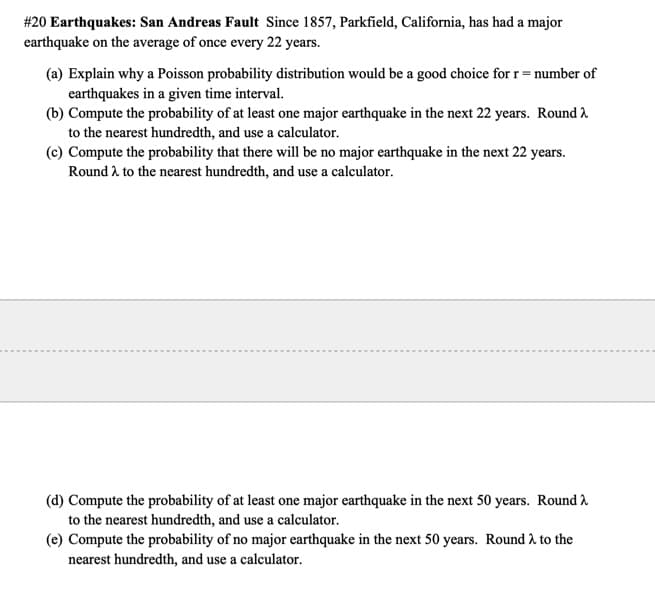(a) Explain why a Poisson probability distribution would be a good choice for r= number of earthquakes in a given time interval. (b) Compute the probability of at least one major earthquake in the next 22 years. Round 2 to the nearest hundredth, and use a calculator. (c) Compute the probability that there will be no major earthquake in the next 22 years. Round à to the nearest hundredth, and use a calculator.
(a) Explain why a Poisson probability distribution would be a good choice for r= number of earthquakes in a given time interval. (b) Compute the probability of at least one major earthquake in the next 22 years. Round 2 to the nearest hundredth, and use a calculator. (c) Compute the probability that there will be no major earthquake in the next 22 years. Round à to the nearest hundredth, and use a calculator.
Chapter8: Sequences, Series,and Probability
Section8.7: Probability
Problem 35E: Unemployment In 2015, there were approximately 8.3 million unemployed workers in the United States....
Related questions
Question

Transcribed Image Text:#20 Earthquakes: San Andreas Fault Since 1857, Parkfield, California, has had a major
earthquake on the average of once every 22 years.
(a) Explain why a Poisson probability distribution would be a good choice for r= number of
earthquakes in a given time interval.
(b) Compute the probability of at least one major earthquake in the next 22 years. Round 2
to the nearest hundredth, and use a calculator.
(c) Compute the probability that there will be no major earthquake in the next 22 years.
Round 2 to the nearest hundredth, and use a calculator.
(d) Compute the probability of at least one major earthquake in the next 50 years. Round 2
to the nearest hundredth, and use a calculator.
(e) Compute the probability of no major earthquake in the next 50 years. Round 2 to the
nearest hundredth, and use a calculator.
Expert Solution
This question has been solved!
Explore an expertly crafted, step-by-step solution for a thorough understanding of key concepts.
This is a popular solution!
Trending now
This is a popular solution!
Step by step
Solved in 3 steps with 3 images

Recommended textbooks for you

